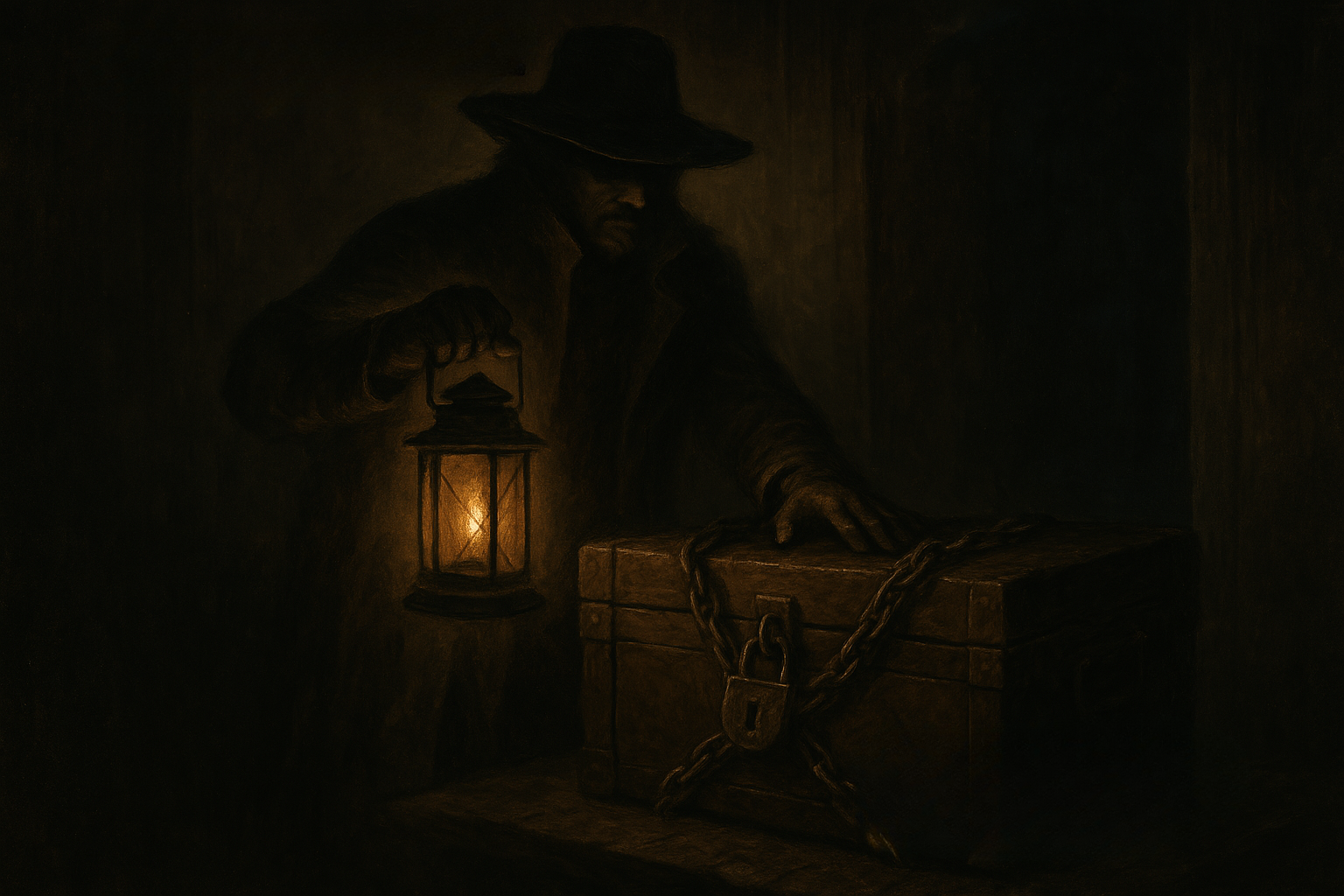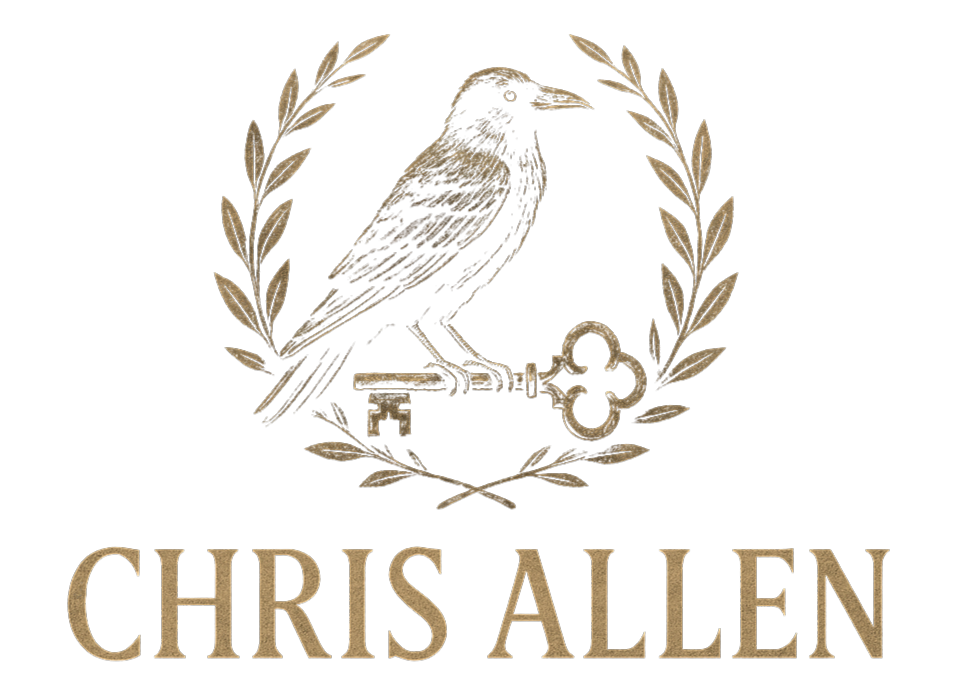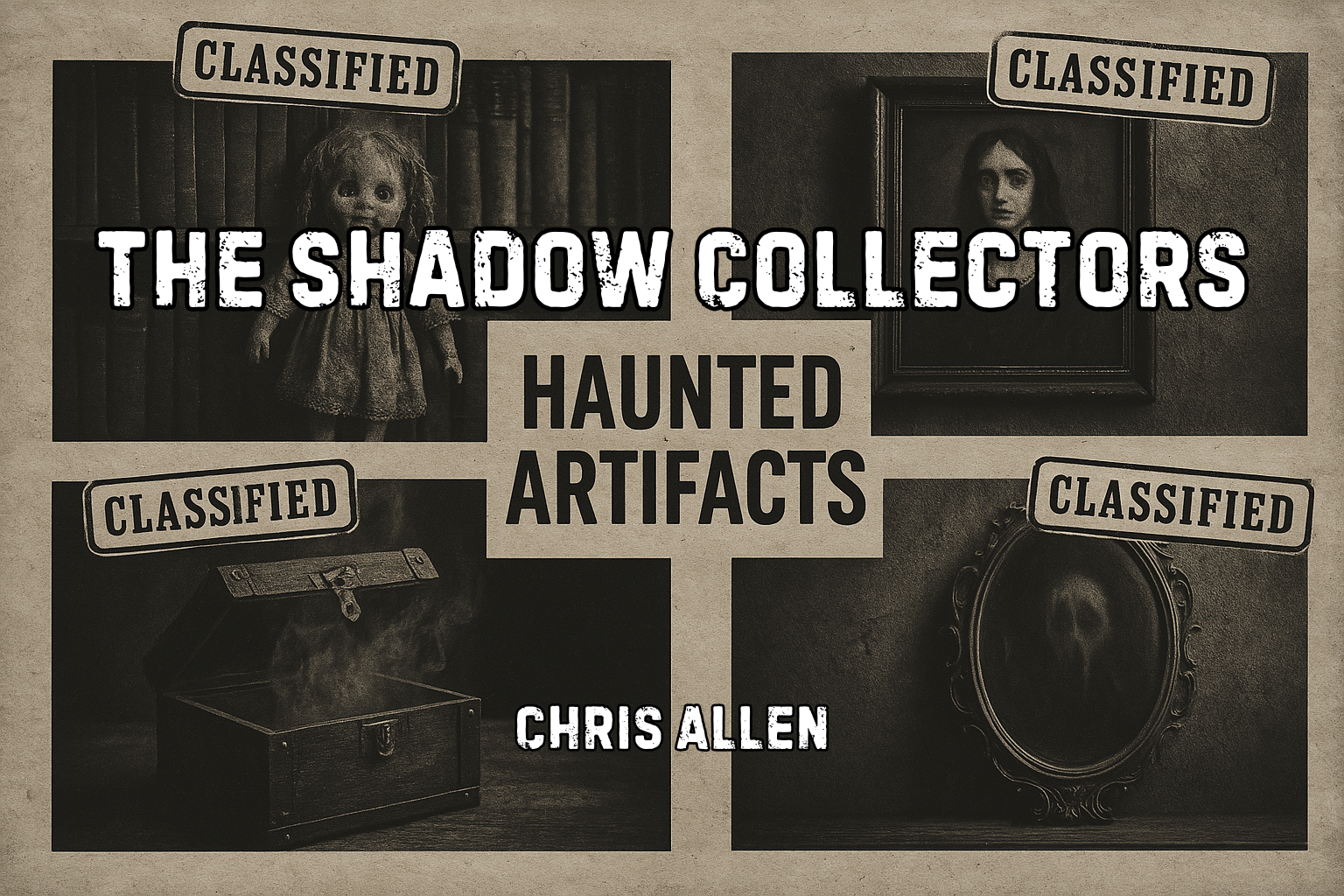London, 1921 – The gaslight flickered as a small group of men and women huddled in the back room of an antiquarian’s shop. An auction was underway, but no ordinary heirloom was on the block. On a velvet-draped table sat a sealed porcelain urn, its surface etched with unfamiliar sigils. The air around it felt heavy. “Lot 13,” the auctioneer announced in a low, reverent tone. “Artefact retrieved from the Blackwood Estate séance room. Contents… he paused, gloved hands resting on the urn …allegedly the spirit of a child, bound by ritual.” A hush fell. The bidders – a mix of occult scholars, a uniformed military observer, and a veiled noblewoman – shifted in their seats. For a moment, it seemed the room itself breathed. A curious scratching echoed from inside the urn, and the candle flames bent away from it. Unperturbed, the auctioneer began the bidding at an astronomical sum. In that dimly lit chamber, the assembled collectors were not trading art or jewels, but something far more disquieting: a trapped ghost. Each was willing to pay dearly to possess it. Thus opened another chapter in the clandestine history of The Shadow Collectors, those secretive souls who traffic in things that should not exist – a hidden market dealing in haunted artifacts and restless spirits.
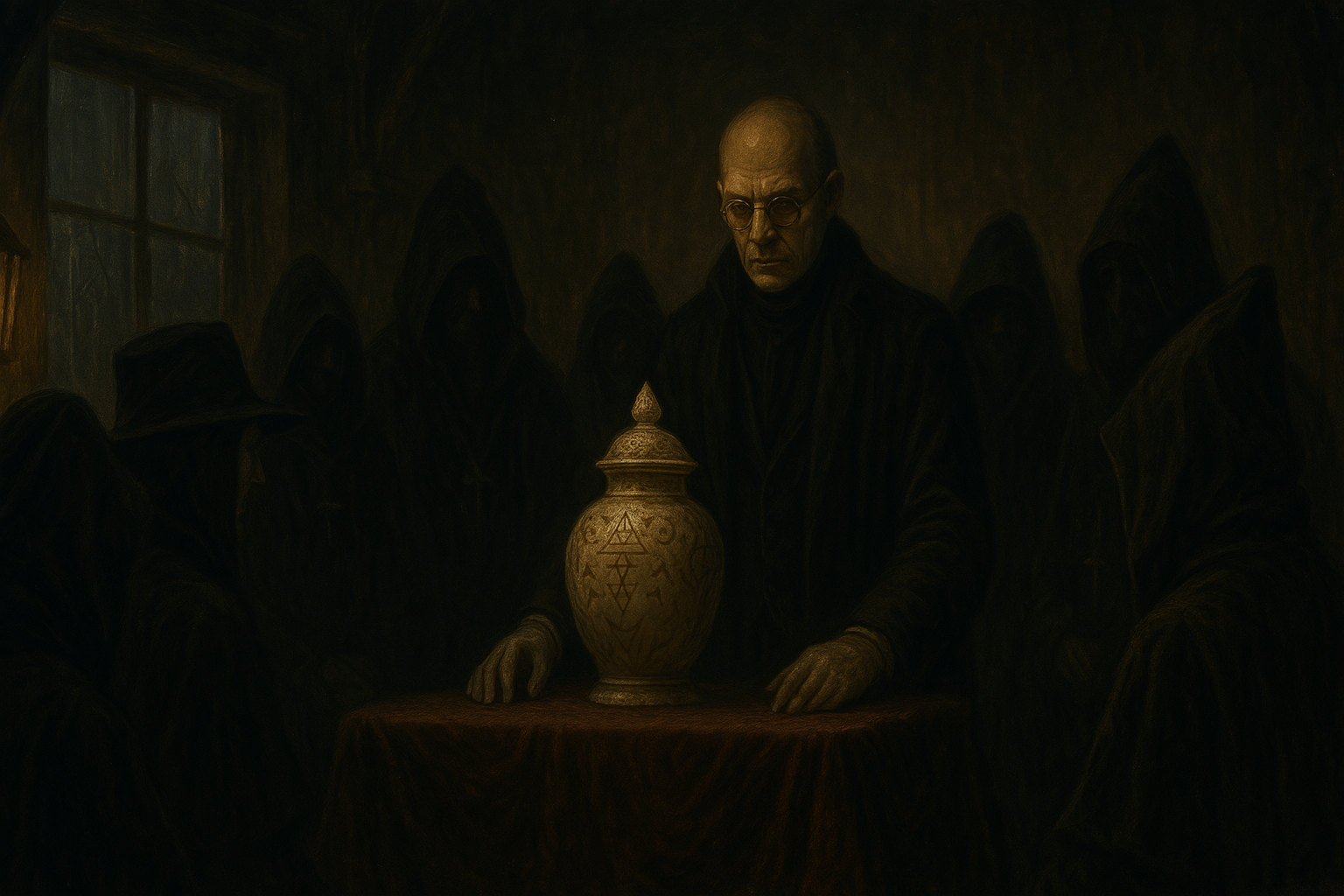
Origins: Binding Spirits in Myth and Folklore
The idea of capturing a spirit – to bottle a ghost or bind a demon – is as old as human fear itself. Long before modern “Shadow Collectors” skulked through estate sales and back-alley auctions, ancient peoples around the world told stories of sorcerers, shamans, and priests who could trap otherworldly beings. In global folklore, the line between myth and reality blurs; what one culture calls a fable, another treats as a very real cautionary tale. To understand the Shadow Collectors of today, we must trace their roots to these early whispers and rituals.
In the ancient Middle East, legends speak of King Solomon wielding a mighty seal ring to command demons and jinn. By late traditions, Solomon confined 72 rebellious spirits into a brass vessel and cast it into the sea – perhaps history’s first “spirit trap” on record. Centuries later, an Arabian fisherman would dredge up a similar sealed jar in the tales of One Thousand and One Nights. When he broke the wax seal marked with Solomon’s sigil, an enormous, wrathful jinn roared free, furious at centuries of imprisonment. The Genie in the Bottle trope was born of these stories, reflecting a deep cultural memory that spirits can be contained – if one knows how.
Across Europe, a more homegrown form of spirit trap emerged in the Middle Ages: the witch bottle. Folk magic practitioners, or cunning folk, crafted these crude yet potent devices to capture evil directed their way. A typical witch bottle was a small glass jug or ceramic jar filled with the victim’s urine (to lure the curse or spirit), sharp pins or nails (to impale it once inside), and often a bit of hair or blood. The bottle would be buried under the hearth or at the far corner of a property. The belief was that a malevolent spirit sent by a witch – or the witch’s projecting spirit itself – would be drawn into the bottle and trapped on the sharp pins, unable to harm the intended target. Hundreds of such bottles have been unearthed in England and New England, corked and spell-bound, testifying that our ancestors truly fought unseen foes by imprisoning them in bottles and jars. While ostensibly meant to “counter” witchcraft, the witch bottle is essentially a ghost trap – an attempt to bind a spirit in a container, not unlike Solomon’s brass vessel on a humble scale.
Not all spirit containers were meant as protection; some were designed for power or profit. In West African and Afro-Caribbean traditions, there are tales of sorcerers known as bokors who can capture a portion of a human soul. In Haitian Vodou, it’s said a bokor may trap a recently deceased person’s “ti bon ange” (little good angel, part of the soul) in a clay jar or bottle. This imprisoned soul, often termed a zombi astral, can then be sold or bargained – perhaps as a charm for good luck, or a curse to be unleashed on an enemy. The purchaser isn’t buying a trinket; they are literally buying a spirit to do their bidding. This disturbing commerce in souls gave rise to many horror stories of “zombie bottles” and soul jars discreetly changing hands. While much of this lore is secretive and hard to verify, it underscores a recurring theme: throughout history, some have sought to capture spirits as one might catch an animal, and others have been willing to pay for those captures.
In the villages of China, old folktales tell of Taoist sorcerers and Buddhist monks skilled in ghost-catching. Armed with sword-shaped talismans, mirrors, or hollow gourds, these masters would confront wayward spirits. One popular tale describes a rogue ghost tormenting a town until a wandering Taoist priest arrived. He brandished a calabash gourd (葫芦, húlu) painted with charms, and, after a fierce astral battle, sucked the ghost into the gourd like smoke in a bottle. With a quick seal of a parchment talisman over the opening, the spirit was safely confined. Such imagery is common in Chinese legends – even the beloved novel Journey to the West includes an episode where Sun Wukong outsmarts demons wielding enchanted gourds that can snatch souls. To this day, the gourd remains a symbol of healing and spirit containment in Chinese culture, often seen in Feng Shui or hanging in homes to absorb negative energies. Trapping a spirit in a vessel, then, is not a new concept in the East either; it’s an accepted bit of magical wisdom passed down through generations, usually as a means to remove a dangerous ghost from circulation.
South Asia offers its own twist. In rural India, one might hear whispers about a tantrik – a practitioner of arcane rites – who keeps spirits as servants. An astonishing modern account comes from an Indian yogi recalling his youth: he befriended a local ghost-practicing tantrik renowned as a “ghost buster.” This man, it was said, had dozens of ghosts in bottles hidden in his home shrine. Each bottle purportedly held a different entity – one a woman’s restless spirit, another an angry man’s ghost – all bound by the tantrik’s rituals. The young seeker visited, eager to see a ghost with his own eyes. The tantrik eventually allowed him into a backroom lined with shelves of stoppered glass bottles, each carefully labeled with occult sigils. “In this one, a drowned woman from the river,” the old man pointed out casually, tapping a cloudy bottle. “Here, a headless one that answers questions.” The visitor saw only dust motes swirling inside, but the notion that each corked vessel held a conscious presence left him awestruck – and a little frightened. Such figures in India and Bangladesh are often feared and shunned, operating on society’s fringes. Yet their existence is an open secret: some people do seek out tantriks to trap troublesome ghosts – for a hefty fee, of course – thereby spawning a quiet economy of spirit-trapping in that part of the world.
Even in the Americas, versions of spirit traps appear in folklore. African-American hoodoo tradition (rooted in Central African beliefs brought by enslaved peoples) gave rise to the beautiful yet eerie custom of the bottle tree. Shimmering blue and green bottles are hung on bare tree branches outside the home. At night, evil spirits are said to be attracted to the glimmering glass and creep inside, only to find themselves unable to escape the bottle’s narrow neck. When the morning sun rises, its rays heat the glass and destroy the trapped haints (haunts) inside. What looks like yard art in parts of the American South actually carries a rich legacy of spiritual pest control, quietly stating that malevolent spirits can be caught and neutralized with the right trap. Similarly, on the Great Plains and in Mexican curanderismo, healers might crack a raw egg or lemon over a bewitched patient to absorb a spirit or illness, then dispose of it – effectively capturing the bad mojo into a temporary vessel to carry it away. All of these practices, whether in Appalachia or the bayous, echo the same mindset: the incorporeal can be contained in the corporeal.
One fascinating cross-cultural motif is the spirit doll – an object given a life of its own by housing a spirit. In Thailand, for example, small effigies known as Kuman Thong have been made for centuries: these are doll-like figures purportedly inhabited by the spirit of an unborn child. Traditionally created through grim means (using fetal remains and necromancy), the practice evolved over time. By the 21st century, a trend called “Luk Thep” (Child Angels) swept Thai pop culture, where people purchased lifelike child dolls that Buddhist monks ceremonially invited a benevolent spirit to inhabit. Owners doted on these dolls – feeding, clothing, and pampering them – believing the indwelling spirit would bring good fortune. Within a year or two, thousands of such spirit-infused dolls were sold, effectively commodifying the ownership of a ghost for blessings. Though this craze was out in the open (with airlines even offering half-price seats for the dolls), it stemmed from an older, more secretive practice of binding ghosts in effigies. And Thailand is far from alone; Japan’s famed Okiku doll at Mannenji Temple, with hair that mysteriously grows, is said to be inhabited by the spirit of the young girl who once owned it. The family, grieving her loss, felt her essence move into the doll – and when its hair began to lengthen inexplicably, they took it as proof and entrusted the doll to the temple for safe keeping. To this day, monks trim Okiku’s unnaturally growing hair as part of their duties. Here, we see ghosts not forcibly trapped, but almost invited or persuaded to reside in an object, forming a bond that later caretakers must respectfully manage.
From the frozen fjords of Scandinavia (where old sagas tell of tricking a mischievous spirit into a carved box) to the deserts of Arabia and the deep forests of the Congo, one finds recurring folklore: restless spirits can be confined, whether by trickery, invocation, or force. Sometimes it was to protect the living – bind the demon, end the plague – and other times, to gain power – command the djinn and have your wishes. These early stories laid the groundwork for what would become a real-world pursuit. For if one truly believes a spirit can be captured, the next thought follows naturally: what could be done with such a captive? Enter the collectors – part hero, part villain, always enigmatic – who would seek to answer that question in the centuries to come.
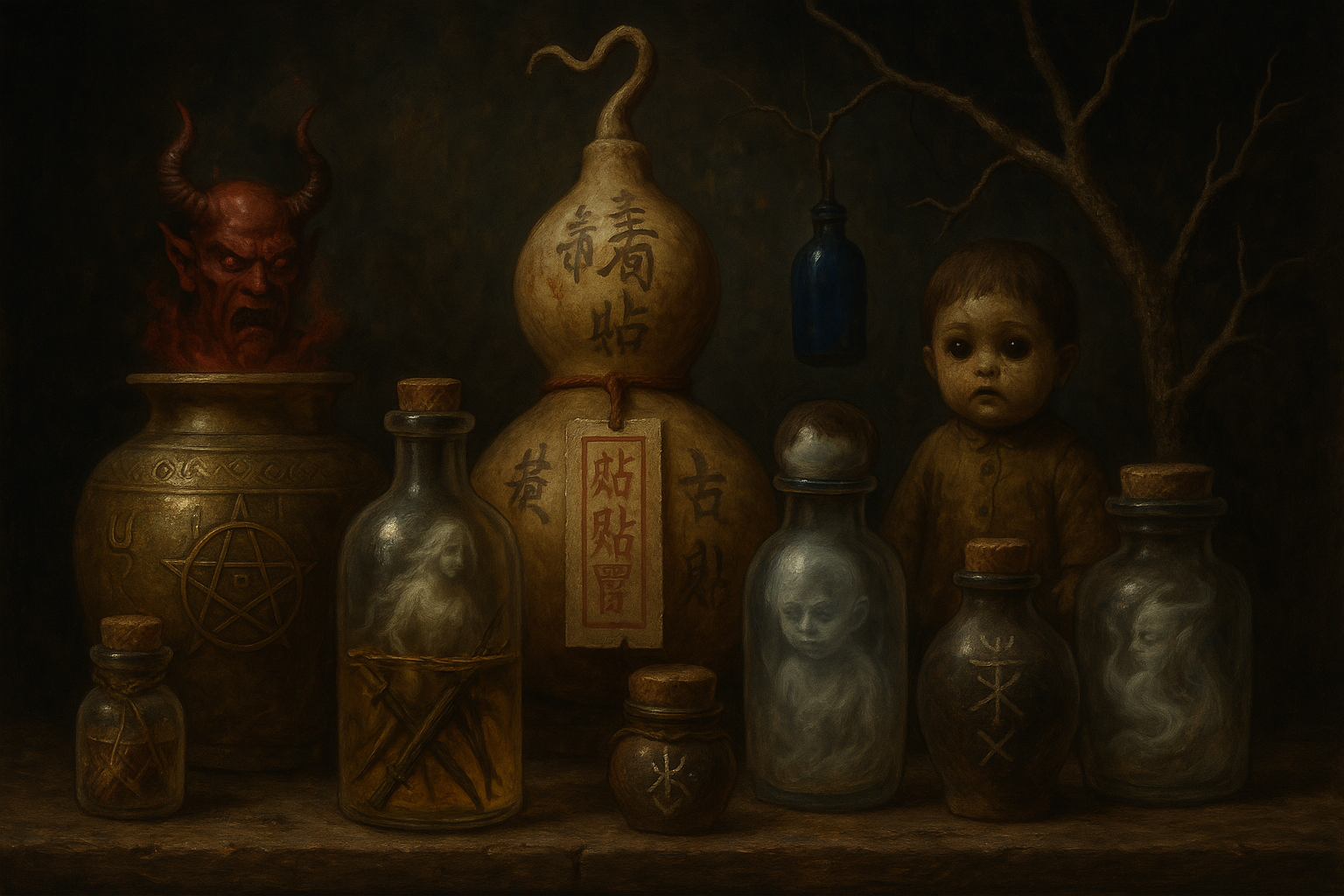
The Trade: Curios, Curses, and a Marketplace of the Macabre
By the 18th and 19th centuries, as the age of Enlightenment met the Gothic imagination, the idea of haunted or cursed objects shifted from purely folklore into a strange kind of commodity. What had once been whispered about in superstition (“Don’t touch that, it’s cursed!”) began to attract the more daring sort of curiosity (“I’ll pay you handsomely for that cursed artifact”). As global exploration and colonialism brought exotic artifacts to European parlors, rumors of cursed idols, haunted relics, and bewitched antiques only fueled their allure. A macabre marketplace was born, one that would evolve and continue right up to the internet age – always in the shadows, just out of sight of polite society.
In the 1800s, Spiritualism took the Western world by storm. Séances, spirit mediums, and ghostly phenomena became a parlor craze. With it came a burgeoning interest in objects that might serve as conduits or cages for spirits. Mediums commonly used tools like spirit boards, planchettes, or “spirit cabinets” (enclosed spaces where apparitions supposedly manifested). These weren’t sales items per se, but they introduced the notion that physical objects could hold spiritual energy. If a simple table could knock and rap answers from “the other side,” imagine what an item already linked to a tragic death might do. This era produced its share of haunted object tales that blurred truth and fiction. For instance, museums and private collectors in the late 19th century vied for Egyptian mummies and funerary relics – not just for archaeology, but for the frisson of the Pharaoh’s Curse. The infamous case of the “Unlucky Mummy” (a gilded coffin lid rumored to cause death and disaster) made headlines in Victorian Britain. Though greatly exaggerated by tabloids, such stories firmly established that there was a market for items with a scary reputation. The logic was peculiar: some buyers were skeptics wanting to prove it all hokum, others were believers thinking they could master the curse, and many were just thrill-seekers collecting morbid conversation pieces. Collecting haunted artifacts, in short, became a gentleman’s hobby for a few intrepid souls.
This period also saw the rise of antiquarian societies and even early paranormal investigators. By the turn of the 20th century, organizations like the Society for Psychical Research (SPR) in London were documenting hauntings and psychical events in a serious way. Sprinkled through their journals are mentions of “haunted houses” with specific items at the center – a particular mirror that “remembers” a tragedy, or a family portrait that seems to carry a curse. Often the solution proposed by investigators was to remove the object from the premises. But remove it to where? In some cases, it quietly found its way into the hands of a willing collector. It was around this time that an insidious idea took root: if an artifact was haunted, one could extract it from public circulation and keep it in private hands, either for study or for safekeeping. The Shadow Collectors of later years would echo this logic: remove the bullet to neutralize the gun, so to speak – except in this case the bullet is a ghostly presence and the gun a house or person it’s tormenting.
Throughout the 20th century, world events inadvertently fed the trade in cursed and haunted items. The World Wars, for example, displaced countless artifacts. After World War II, Allied soldiers and returning officials sometimes brought home bizarre souvenirs from ravaged Europe. Some of these had occult connections: there were whispers that American GIs recovered Nazi ceremonial paraphernalia imbued with dark symbolism – swastika-emblazoned ritual daggers, a broken piece of the “Spear of Destiny” that Hitler had coveted (itself a relic said to make or break the fate of empires), or crates of oddments looted by the Nazis from around the world. While much was turned over to museums or lost, rumors persisted that a few pieces with sinister reputations disappeared into private collections. Imagine a vault in some Midwest attic containing a charred chunk of a Gothic altarpiece rumored to bleed, taken from a secret SS bunker – it sounds like a pulp thriller, yet black market channels in the post-war chaos certainly existed. Meanwhile, in Europe, the economic hardship after war meant old family heirlooms with dark pasts were quietly sold off. A cursed Italian vase that had reportedly caused the deaths of several owners resurfaced in the late 1940s – the so-called Basano Vase, a 15th-century silver bridal vase. According to legend, it was buried for decades with a warning note and dug up by an unwitting family. After causing new misfortunes, it finally went to auction and was bought by a mysterious bidder – only to vanish from records, as no museum ever claimed to have it. Many believe that vase still rests in some private trove, its curse contained as long as no one handles it. Such post-war fire sales of cursed items may have quietly enriched the inventories of Shadow Collectors operating under the radar.
By the late 20th century, the trade in haunted artifacts took an even more peculiar turn, intersecting with popular culture and technology. The rise of online marketplaces brought this niche out of dusty curio shops and into a strange sort of semi-public view. During the early 2000s, eBay became an unexpected bazaar of the bizarre. Collectors and curiosity-seekers could suddenly browse listings for “Haunted Victorian Doll, very active” or “Cursed Dibbuk Box – Do Not Open!” from the comfort of home. Sellers spun elaborate backstories for these items: a ring inhabited by a helpful djinn, a painting that cries at night, a child’s doll occupied by the spirit of a little girl looking for a mother. It was the digital age’s answer to the old carnival sideshow, except in this case you could become the proud (or unfortunate) owner of the oddity. One infamous listing was “The Dybbuk Box” – a simple wooden wine cabinet that a seller in 2003 described as containing an evil spirit from Jewish folklore, bound by a Holocaust survivor and inadvertently released to plague subsequent owners. The online story of the Dybbuk Box went viral: each owner recounted how the box brought horrible nightmares, illnesses, freak accidents. Finally, it was bought by a museum curator who vowed to seal it safely away. (Years later, this very box would reappear in a Las Vegas haunted museum – more on that soon.) The fervor around the listing cemented the Dybbuk Box as perhaps the most famous “haunted artifact” of the internet era, even inspiring a Hollywood horror film. It also proved there were real customers for such things. The box sold for hundreds of dollars despite (or because of) its ominous reputation.
Sensing a market, scores of other sellers followed. For every sincere paranormal enthusiast trying to rehome a spooky heirloom, there were undoubtedly pranksters and profiteers flooding the category with junk dressed up in ghost stories. So many “haunted dolls” cropped up that eBay eventually created rules about selling intangible entities (they officially banned the sale of souls, ghosts, and spells around 2012, though haunted objects with a “for entertainment only” clause were still allowed). Nonetheless, a subculture of haunted item trade thrived. Dedicated websites and forums popped up where one could trade ghostly goods outside of eBay’s reach. A full-time haunted object purveyor might scout estate sales for any item with a creepy tale attached or even conduct séances to “invite” a spirit into a willing object, then put it up for sale. Buyers ranged from paranormal investigators looking for trigger objects (items that might attract or house a spirit for study), to collectors who just truly loved oddball things, to people who believed a particular spirit might bring them luck or companionship. It became clear that, even out in the open, the haunted artifact market was alive and well – an eccentric cousin of the antiques world sustained by storytelling and superstition.
While much of this trade is niche and online, there have also been high-profile sales and acquisitions that brought haunted artifacts into the spotlight. For instance, in 2018 an auction house in the U.K. quietly listed an antique mirror from the estate of Titanic’s former captain, Edward Smith. The mirror, according to the seller (a relative of Smith’s housekeeper), supposedly showed Captain Smith’s ghostly face on the anniversary of the Titanic sinking. This “haunted mirror” made news when famed paranormal collector Zak Bagans purchased it for display. Bagans, known as a ghost-hunting TV host, has in recent years turned what was once a secretive pursuit into a public attraction: a museum of haunted artifacts. His Haunted Museum in Las Vegas houses dozens of notorious items he’s collected, from the original Dybbuk Box to gruesome curios like a cauldron used by serial killer Ed Gein (rumored to carry a dark presence). Bagans reportedly spent large sums at auctions to obtain some of these headline pieces – tens of thousands of dollars for the “cursed” rocking chair from the Devil Made Me Do It exorcism case, for example. It’s a reminder that the trade isn’t only confined to anonymous eBay buyers; even celebrities and TV personalities have entered the arena, sometimes publicizing the very artifacts that once would have only swapped hands in secret.
But for all the notoriety of a Zak Bagans or the charm of online doll sellers, there remains an undercurrent of the truly shadowy trade – the kind that isn’t advertised on social media or followed by TV cameras. Within paranormal circles, there are hushed rumors of a black market for the truly dangerous items, the sort that no sane antiques dealer would dare openly list. Imagine fragments of a haunted house’s staircase where apparitions are bound, or a set of medieval “cursed coins” that supposedly carry a death omen to each new owner. These aren’t the kind of things you’ll find at estate sales with a polite label. The stories say that when such objects are found, they change hands quietly for large sums among an inner circle of collectors. Some deals are allegedly brokered via middlemen who specialize in “removing” hauntings – essentially freelance exorcists who keep whatever they remove. If they judge an item to have resale value to a collector (for study, or morbid fascination, or even ritual use), they might sell it on rather than destroy it. It’s impossible to verify how often this truly happens, but consider: when a family desperately wants a cursed painting out of their lives, and a known collector steps in offering cash to take it off their hands, would they refuse? Probably not. Thus, a secret pipeline is maintained between the frightened afflicted and those bizarrely eager to acquire what afflicts.
Over time, a loose network of these “Shadow Collectors” seems to have coalesced – individuals who might even know of each other in passing, contacting one another when a rare opportunity arises. One collector in the network might say, “I’ve heard of an estate in rural France where the owner kept a mirror that shows a lady in gray; he passed, and the heirs are terrified of it. Are you interested?” And another, perhaps a specialist in haunted mirrors, will discreetly arrange a pickup. The trade often relies on discretion and trust, as those selling the item prefer anonymity (to avoid publicity or ridicule), and those buying do not want to advertise that they possess such cursed goods (for fear of theft, or the ethical quandaries of admitting they have a potentially dangerous item). It operates in a gray area of legality and belief – after all, to the law a “haunted object” is just an object. But the transactions involve an understanding between both parties about the real nature of the item, a wink and a nod that “you know what you’re really buying.”
One can only estimate the size of this underground marketplace. It likely ebbs and flows with society’s interest in the paranormal. In the 1970s, during the boom of occult fascination, there were whispers of classified ads in back pages of paranormal magazines, with coded language like “Curio collectors seeking rare oddities, will pay top $$ for items of unusual history.” In the 1990s, perhaps a lull; then the 2000s internet brought it to light again. Today, with instant global communication, a desperate seller in South Africa claiming a haunted tribal mask can find a willing buyer in Canada with a few keystrokes on a forum. The Shadow Collectors are no longer limited by geography – only by their own secrecy.
Throughout all these dealings, one question looms: Why do they do it? Why would someone want a painting said to cry with the voice of a dead child, or a ring purportedly housing a genie? Motives vary. For some, it’s an altruistic urge – the same impulse as the Warrens (the famous husband-wife demonologist team of the 20th century, more soon) who would say they took cursed objects “out of circulation to keep others safe.” A collector with a conscience might genuinely think they’re the best person to contain the artifact properly, to ensure it harms no one else. Others have a scientific or at least inquisitive drive – they want to study the paranormal under controlled conditions. If you have a ghost in a box, perhaps you can test it, communicate with it, prove or disprove its existence. Indeed, having a tangible haunted object is a dream for many paranormal researchers because it offers repeatable experimentation that a one-off haunted house visit cannot. And then, inevitably, there are those darker motivations: power, prestige, or obsession. An occultist might seek to extract the power of a bound spirit – using it for spellwork, gaining secret knowledge, or even just gloating over a literal demon-on-a-leash. A wealthy eccentric might relish owning what others fear, adding to his cabinet of horrors like a trophy. In the hidden economy of haunted artifacts, every item carries not just a ghost, but a story – and for some, owning that story is the ultimate prize.
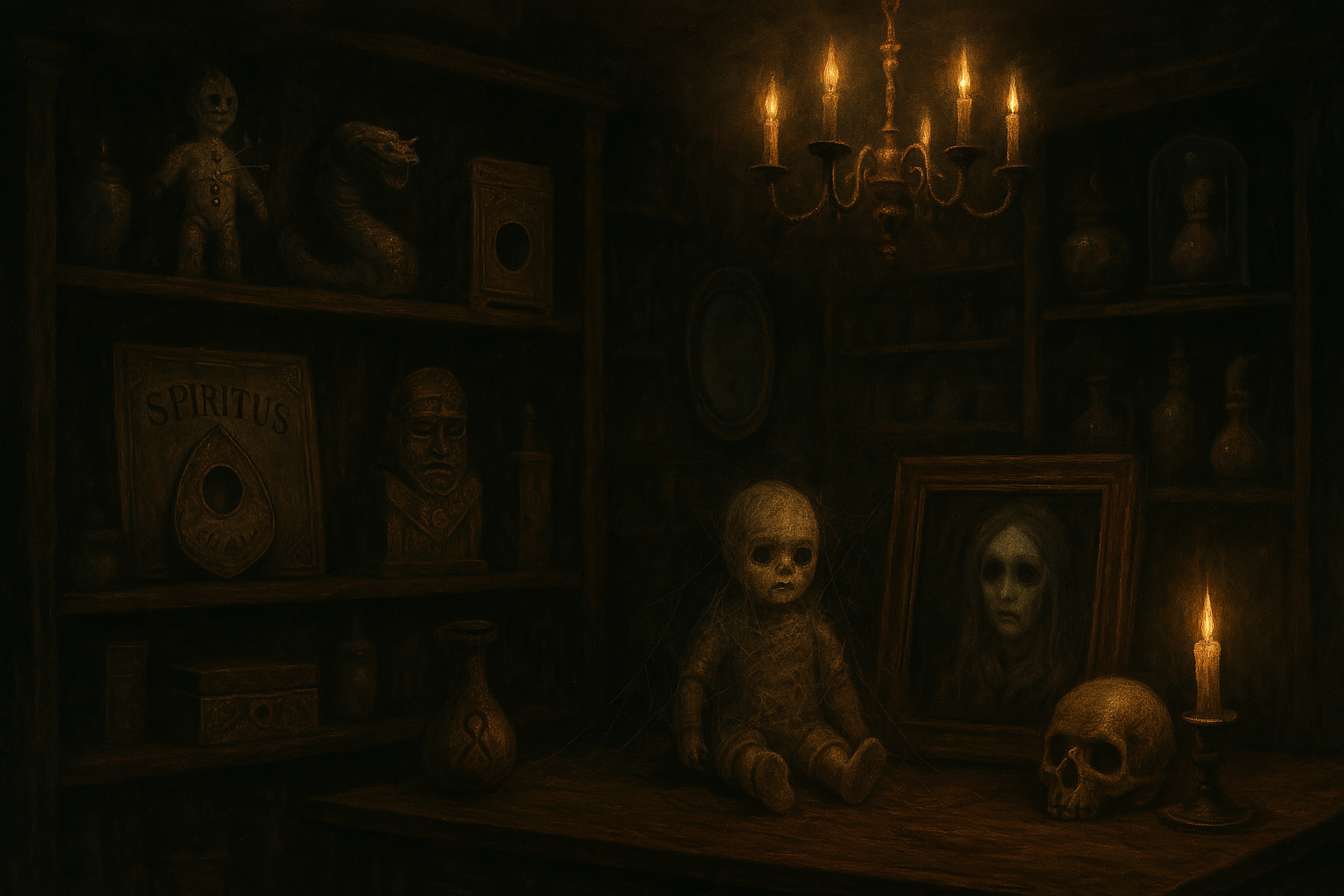
Black Files and Secret Societies: In the Shadows of Power
Behind the odd transaction or two lies a bigger, more tantalizing possibility: that some of the world’s institutions and elite groups have long taken an interest in paranormal artifacts – quietly cataloging them, studying them, or weaponizing them. If true, it means that the Shadow Collectors aren’t just quirky loners on eBay or reclusive occultists in mansions. They could include government agents, military intelligence units, and members of secret orders who operate with impunity and resources far beyond the average ghost hobbyist. While hard evidence is scarce (as one might expect for such secretive dealings), conspiracy theories and a few declassified snippets weave an intriguing tapestry known informally among researchers as the “Black Files.”
Governments and militaries have officially dabbled in the paranormal – this much is documented. The U.S. Army’s Project Stargate (1970s–80s) tried to cultivate psychic spies; the Soviet Union invested in telepathy and psychokinesis research at secret institutes. These are matters of record. But did any government ever try to harness haunted objects? There are hints, if one reads between the lines of certain files. In 1973, during the Cold War’s strangest years, the CIA launched an offshoot of MKULTRA nicknamed Project MK-OFTEN. Though many details remain classified or lost, insiders whispered that MK-OFTEN explored “occult” avenues for intelligence gathering, even consulting spirit mediums, sorcerers, and practitioners of witchcraft. One account claims that agents involved in MK-OFTEN sought out cursed artifacts to see if they could be used to, say, assassinate or influence targets from afar. Could a cursed object be placed in an enemy official’s office to plague them with misfortune? Could a bound spirit be commanded to spy or sow terror? These ideas sound like science fiction, but declassified memos do show CIA officials meeting with self-proclaimed “warlocks” and exploring demonology as a bizarre tangent of psychological warfare. Perhaps they never got as far as actually catching a ghost, but one shudders at the ethical void required even to ask such questions.
Across the ocean, in the U.K., rumors swirl about a department of the Ministry of Defence during the 1980s that kept a “registry” of supernatural occurrences. One often-cited (though elusive) story involves a British Intelligence officer stumbling upon a haunted object during the Troubles in Northern Ireland – specifically a Celtic relic that local lore held was cursed. According to the story, rather than dismiss it, MI5 quietly relocated the item to a safehouse for observation, and it was noted in an internal file titled “Unusual Artifacts – Eyes Only.” No one outside the agency has seen these so-called Black Files, if they exist, but believers suggest that multiple governments maintain such secret archives of haunted or occult items, much like they would stockpile captured weapons. It’s essentially the “Warehouse 13” scenario (a popular TV fiction about a secret government warehouse of supernatural relics) – a fantasy perhaps, but one that many find plausible given how often truth approaches fiction in the murky world of espionage.
The military interest, if it exists, wouldn’t be entirely unprecedented historically. During World War II, the Nazi regime under Heinrich Himmler’s SS invested heavily in occult research through an institute called the Ahnenerbe. They scoured Europe and Asia for legendary artifacts: the Holy Grail, the Spear of Destiny, the Sword of Attila – objects that were more holy relics than haunted toys, but prized for their supposed mystical power. Alongside these quests, Nazi investigators compiled the “Hexenkartothek,” a massive archive on witchcraft and pagan lore, possibly hoping to rediscover ancient supernatural secrets. While there’s no confirmed case of Nazis trapping a ghost in a box, some of their expeditions bordered on the paranormal. One speculation is that in their raid of museums and private collections, the Nazis did seize items with fearsome reputations – such as a medieval “cursed mirror” from a castle in Belgium, or grimoires (spell books) said to be bound with demon servitors. At the war’s end, the Soviets and Americans divvied up not only rocket scientists but also esoteric loot. It is believed the Soviet SMERSH unit and American OSS agents each intercepted occult materials from the Nazis. Some of these became mere curiosities in intelligence archives; others might have been quietly tested. Consider that Soviet science embraced psychic experiments – would they ignore a reportedly haunted relic if it came into their possession? Decades later, some Russian defectors hinted that the KGB’s successor had a vault of “anomalous objects” locked away, including things retrieved from Chernobyl’s site (where witnesses spoke of ghostly apparitions post-disaster) and from Siberian gulags with dark legends. True or not, the notion that superpowers kept paranormal stockpiles persists in conspiracy lore.
Beyond government halls, secret societies and religious orders are often invoked as key players in the Shadow Collector realm. The Catholic Church, for instance, has a well-known cadre of exorcists whose job is to expel demons and unclean spirits. What becomes of the physical focus of these exorcisms – the possessed doll, the cursed relic, the haunted house artifacts? Officially, the Church’s policy is usually to destroy objects deemed cursed or infested. Holy water, fire, or burial in hallowed ground are the common ends for things like Ouija boards from exorcism cases or idols from pagan rites. However, whispers have long persisted about the Vatican Secret Archives (now formally the Vatican Apostolic Archives) containing more than just ancient manuscripts. Some claim that hidden in vaults beneath Vatican City are confiscated occult artifacts – a horn said to summon demons, the preserved hand of a famous possessed saint, or boxes sealed with sacraments containing entities that priests could not or would not destroy. The Church would never confirm this, but there are anecdotal accounts: a 19th-century Vatican investigator named Father Ernetti allegedly wrote of a “demon urn” locked away after an exorcism in Spain, its inscribed lid never to be opened. And during the height of the Satanic Panic in the 1980s, a few exorcists mentioned encountering satanic ritual items they turned over to higher authorities. It’s quite possible the Vatican has a private “black museum” of evil objects, not out of desire to collect, but simply as a byproduct of centuries of spiritual battlefield clean-up.
Likewise, other religious or chivalric orders have been tied to ghostly collections. The legendary Knights Templar, accused in 1307 of heresy and idol worship, were said to possess a monstrous carved head called Baphomet. Some theories suggest this head (if it existed) might have been a reliquary that the Templars believed contained a spirit or prophetic entity – a guiding “oracle” for their rites. When the Templars were suppressed, such an artifact would have gone underground. Could it have surfaced in another secret society later, like the Freemasons? The Freemasons, inheritors of many esoteric traditions, certainly collected arcane symbolism but publicly deny any traffic in ghosts or curses. Still, within some Masonic lore, there are references to storing dangerous texts or keeping guardianship of powerful relics. It’s a small leap to imagine a secret lodge within the Freemasons whose members are the keepers of haunted treasures, quietly ensuring they don’t fall into the wrong hands.
In more modern occult circles, figures like Aleister Crowley come to mind. Crowley – the infamous early 20th-century occultist – was an avid collector of mystical items, from ancient Egyptian stele to talismanic rings and grimoires. He and contemporaries in groups like the Hermetic Order of the Golden Dawn traded in all sorts of occult paraphernalia. One story tells of Crowley obtaining an ornate mirror that once belonged to Count Cagliostro (a notorious sorcerer) – a mirror rumored to show horrific visions and drive men mad. Crowley being Crowley, he no doubt tried to scry with it. Whether it was truly haunted or not, these objects often wound up in private collections when their owners died or fled. During World War II, Crowley’s associate (and rival occultist) Dion Fortune purportedly advised British intelligence on counteracting Nazi occult operations. Could some of Crowley’s cursed collectibles have been quietly taken by British agents for safekeeping at that time? It’s speculation, but not far-fetched that occult artifacts moved behind closed doors amidst wartime intrigue.
In recent decades, the intersection of military and paranormal took another curious turn. In the 2000s and 2010s, as Middle Eastern conflicts raged, soldiers brought back stories not just of combat, but of the unknown. U.S. troops in Iraq reported encountering sites locals feared were jinn-haunted. One popular rumor spoke of a special forces team that raided a insurgent hideout only to find ancient Mesopotamian relics being used in rituals – including a copper chest that Iraqi villagers swore held a vengeful spirit. The team, baffled and a bit spooked by inexplicable occurrences around those items, supposedly handed them off to “men in suits” who arrived on a military transport plane. No records, no museums – just whisked away, perhaps to some Pentagon sub-basement. While such war stories often grow in the telling, history shows that genuine archaeological treasures (and curses) did surface amid the Iraq War chaos – the Baghdad Museum was looted, and many items disappeared into the illicit antiquities market. If even one of those items had a notorious reputation (like a relief from the tomb of a Babylonian prince known for a deathly curse), it could easily have been picked up by a collector or even held by coalition forces to prevent local panic.
These entanglements of the supernatural with agencies and orders have given rise to what enthusiasts call the Shadow Network – an alleged web of cooperation (and competition) among various secret collectors. Picture a covert meeting, maybe at a neutral location like a private library’s back room, where a Vatican emissary, a military paranormal consultant, and an independent occult scholar quietly exchange notes. It might sound like the start of a thriller novel, but some insist such meetings have happened under the radar at major paranormal conferences or behind closed doors after an academic symposium on folklore. The topics? Perhaps to trade information or even artifacts that each party has secured. For instance, if a government agent acquired that Iraqi copper chest, they might hand it to the Church for containment if it seemed truly dangerous, or pass it to a civil paranormal foundation for study to avoid official entanglement. In return, the Church might share historical knowledge on a similar case from centuries ago that could help. Whether this collegial Shadow Network truly exists or it’s just an idealized notion, the possibility adds another layer to the mythos of the Shadow Collectors: that beyond lone individuals, there are factions with differing ideologies handling these artifacts. Some might seek to destroy or lock away every spirit-bound object (the containment faction), others aim to research and understand them (the scientific faction), and perhaps a few wish to exploit them (the dangerous faction). Their quiet tug-of-war could be happening under our noses.
One particularly provocative theory posits that certain wealthy families or elites have long curated private “demonologies” – effectively libraries or collections of bound entities passed down through generations. They might not be formal secret societies, but these dynasties operate with similar secrecy. Think of a great mansion in the countryside that outsiders rarely enter. In its cellar lies a climate-controlled vault not of wine, but of locked chests and antiquated cabinets, each containing something unspeakable collected by an ancestor. Perhaps great-grandfather traveled in Asia and returned with a Jade puzzle box containing a wrathful spirit he subdued with the help of monks; great-grandmother, a medium, trapped a spiteful ghost in her beloved music box. These become family secrets, only whispered about at reunions. Over time, the family learns to manage these inheritances – maybe hiring private occultists to perform rituals that keep the entities dormant. They would never sell these items (too risky), but they also will never publicize them, for fear of scandal or theft. Such families could very well exist, their names unknown to us, quietly funding research into exorcism or supporting the more public haunted museums as a safe outlet for “lesser” items. In the conspiracy landscape, these hypothetical elite collectors are sometimes linked with the Illuminati or other cabals – the idea being that those who hold sway over supernatural forces hold a trump card in the game of power.
At this juncture, the Shadow Collectors cease to be mere hobbyists and start to resemble a hidden arm of influence. If one believes these theories, then haunted artifacts are a currency in their own right among those in the know. A cursed relic could be leverage: “Do as we ask, or we’ll ensure this delightful little plague jar finds its way to your home.” An entity in a container could be an information source: “The spirit inside has witnessed centuries; under the right ritual, it might divulge secrets.” It’s a fantastical extension of reality, yet in a world where billionaires fund space rockets and gene editing, is it so outrageous that someone might also fund efforts to secure and study the supernatural?
The truth of these black files and secret dealings remains elusive, likely by design. Occasionally, a tantalizing clue escapes – a leaked email here, an offhand remark by a retired general there, or a curious line in a declassified document that mentions an object behaving oddly. To the average person, it’s easy to brush off. But to the Shadow Collector aficionado, these are breadcrumbs that confirm a hidden ecosystem. They suggest that beyond the lore and the lone weirdos, an organized effort exists to track, acquire, and contain haunted artifacts when needed. Perhaps a global, albeit informal, “Agency of the Occult” functioning in pieces through various institutions. In this light, the Shadow Collectors are not just fringe enthusiasts; they could be unsung (and sometimes unethical) custodians of a reality we’re not ready to face.

Curios and Curses: Notorious Haunted Artifacts and Their Keepers
To better grasp the strange world of the Shadow Collectors, it helps to examine specific cases – the infamous items that have surfaced over time and the people who became entangled with them. Each of these artifacts carries its own dark legend, and in many instances, a journey that involves secretive exchanges or final resting places in private collections. Think of this section as a tour through a gallery of haunted curiosities, each exemplifying how such objects are found, traded, and ultimately secured (or not).
The Dybbuk Box: Wine Cabinet of Woes
Few haunted objects in recent times have captured public imagination like the so-called Dybbuk Box. As mentioned earlier, it began as an eBay listing in the early 2000s, posted by a small-time antiques dealer who had unwittingly acquired a simple wooden wine cabinet from a deceased estate. According to the story he wove, the box had been brought to America by a Holocaust survivor who warned that a malevolent entity (a dybbuk) was sealed inside. Upon opening it, the dealer and subsequent owners experienced a cascade of misfortunes: hair falling out, the stench of cat urine and jasmine, shadowy figures in the periphery of vision, and horrific nightmares of an old hag. One owner’s mother suffered a stroke the very day she opened the cabinet. Terrified, he sold it off. Eventually a museum director named Jason Haxton obtained the box and conducted tests – even consulting rabbis about containing the dybbuk. Haxton reported that the box indeed seemed to harbor something that affected electronics and human health. He kept it hidden away, bound in gold foil and stashed inside a military-grade case in an unknown location. This should have been the end of the Dybbuk Box’s story, locked up as a true “contained evil.” But Shadow Collectors seldom let such prizes lie fallow. In 2016, after years of silence, the box re-emerged when Haxton turned it over to Zak Bagans for his paranormal museum. Today, it sits in a dedicated room, behind glass, with warnings and holy texts adorning it. Visitors have claimed fainting or feeling sick near it. Intriguingly, the original seller later admitted he concocted parts of the story. Was the Dybbuk Box ever truly a spirit trap, or was it a brilliant hoax that manifested a thought-form (a haunting born purely from belief)? The world may never know. Yet, true or not, the Box has a permanent home now – a controlled environment, essentially a high-profile cage for what might be inside. It illustrates how even a possibly fabricated haunted item can become very real to those who possess it, and how coveted such an item can become in collecting circles.
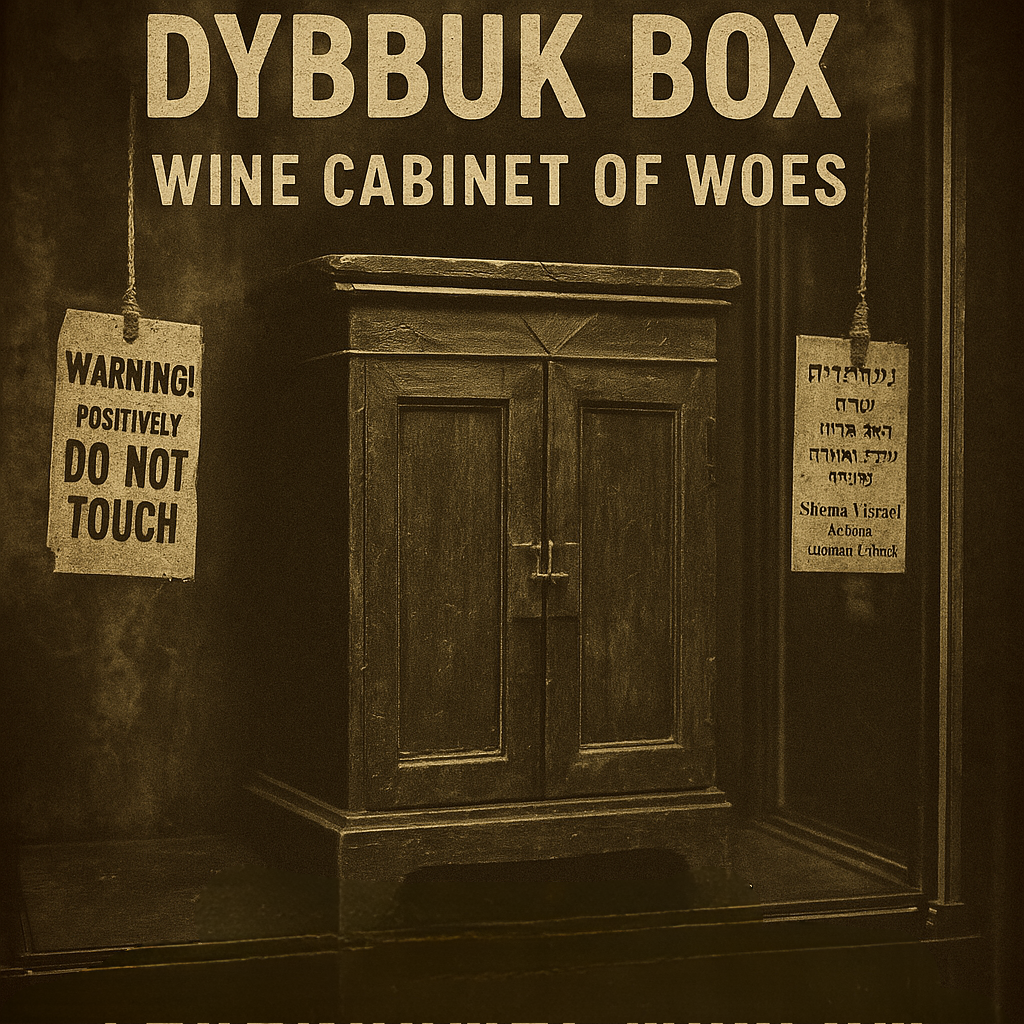
Annabelle: The Raggedy Ann Doll in Glass
Perhaps the most famous “haunted doll” of all time, Annabelle resides in a special case emblazoned with a crucifix and the warning: “Positively Do Not Open.” She is no porcelain Victorian beauty, but a plain ragdoll in a cute dress – belying the disturbing entity attributed to her. In 1970, two college students received the doll as a gift. Almost immediately, Annabelle exhibited classic haunting behavior: changing positions when no one was looking, notes scrawled in childish handwriting appearing on parchment (“Miss me?”), and even a terrifying incident where a male friend was clawed and left with bloody scratches after challenging the doll’s power. Desperate, the students turned to a medium, who claimed the spirit of a dead girl named Annabelle Higgins resided in the doll. Enter Ed and Lorraine Warren, the now-famous paranormal investigators. The Warrens concluded it was not a harmless child spirit at all but a demonic presence using the doll as a conduit – a beacon to potentially possess a human host. They performed a blessing and removed Annabelle from the apartment. Thus began one of the earliest modern instances of proactive artifact containment: the Warrens took possession of the doll to neutralize the threat to others. Annabelle was placed in the Warren’s Occult Museum in Connecticut, a locked room in their home filled with items from various haunting and demonic cases they handled over decades. There, Annabelle sat behind glass, never to be touched. The Warrens would even have a priest periodically recite binding prayers over the collection. The legend only grew as visitors to the museum whispered that Annabelle’s case would sometimes mysteriously show cracks, or that a brash biker who once banged on the glass died in a crash shortly after being asked to leave. Whether truth or mythos, the case of Annabelle set the template: a private collector (in this case, a demonologist couple) acting as custodians for a dangerous artifact. The Warrens’ museum (now closed after their passing) held not just Annabelle but an array of nightmare-inducing objects: a haunted music box from the Amityville house, a conjuring mirror used in summoning rituals, satanic idols, and so on. Each piece was stored rather than destroyed, under the Warrens’ belief that locked away with religious protections was safer – that destroying such items could release whatever lingered. In essence, the Warrens were prototypical Shadow Collectors albeit ones who operated with a public-facing persona, often lecturing about the items to warn others. Annabelle remains in that glass prison to this day, under the care of the Warren’s heirs, a stark reminder of the fine line between protecting the world from an object and proliferating its infamy by keeping it intact.
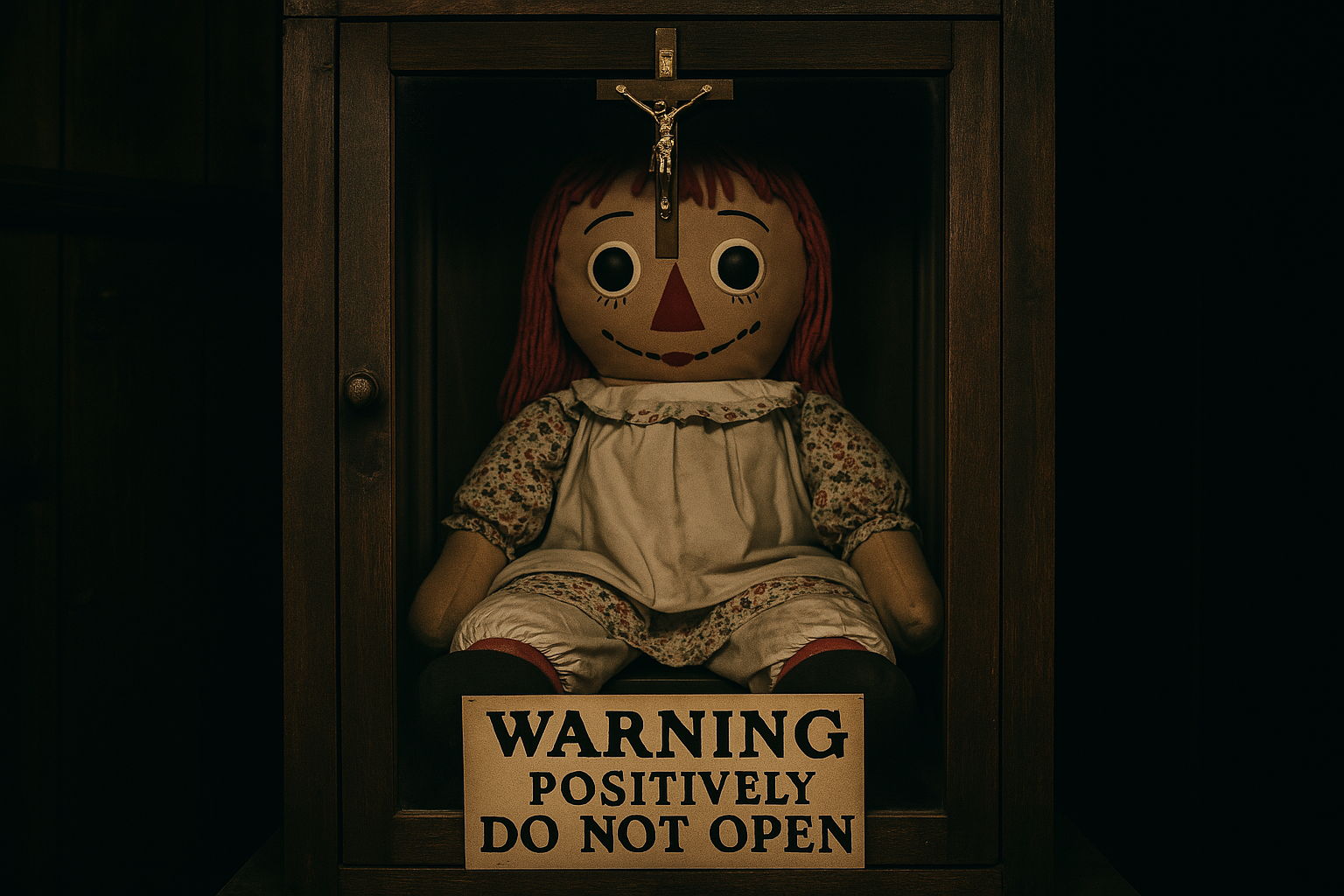
The Conjure Chest: A Legacy of Death
An unadorned mahogany chest of drawers in a Kentucky museum carries a deadly legend from the 19th century. Known as the Conjure Chest, it was handcrafted by an enslaved man for his owner, Jacob Cooley, to celebrate the impending birth of Cooley’s child. The story goes that Cooley, a cruel master, was displeased with the chest and beat the craftsman, Hosea, to death. Fellow enslaved people, enraged by the injustice, cursed the chest through a ritual “conjure” – perhaps embedding a vengeful spirit or dark spell within the wood. The result was a generational curse: tragedy struck Cooley’s family every time the chest was used for something important. Cooley’s firstborn died in infancy (never getting to use the chest as intended for baby clothes). Over the next 150 years, as the chest was passed down, at least 17 deaths were linked to it: accidents, sudden illnesses, mysterious failures. Finally, in the 20th century, a descendant who had lost her son and husband (after storing his clothes in the chest) had enough. In a rare collaboration between folklore and institution, she reached out to a local museum – the Kentucky History Museum – and essentially said, “Take it, but don’t use it.” The museum accepted this morbid donation. A conjure woman was reportedly brought in to perform a ritual to “cool” the curse, involving placing a Bible in one of the drawers. Now the chest sits on display, with an informational plaque rather than an ominous one, but the staff knows the history. It’s essentially a contained cursed object in a public setting, benign as long as no one tempts fate by using it. The Conjure Chest’s journey from private curse to public curiosity is instructive: not all cursed artifacts end up hidden away; some become museum pieces with their power defused (hopefully) by context and care. Yet, one imagines there were other cursed family heirlooms less famous where the owners didn’t involve a museum. Where did those end up? Perhaps in some cases, Shadow Collectors intervened quietly – purchasing the “antique chest” or “old cradle” at a family sale, never revealing they knew its dark reputation, and tucking it away safely. For each Conjure Chest that gets an exhibit, a dozen others might slip into private hands through antique markets, their stories known only to the buyer who recognized it for what it was.
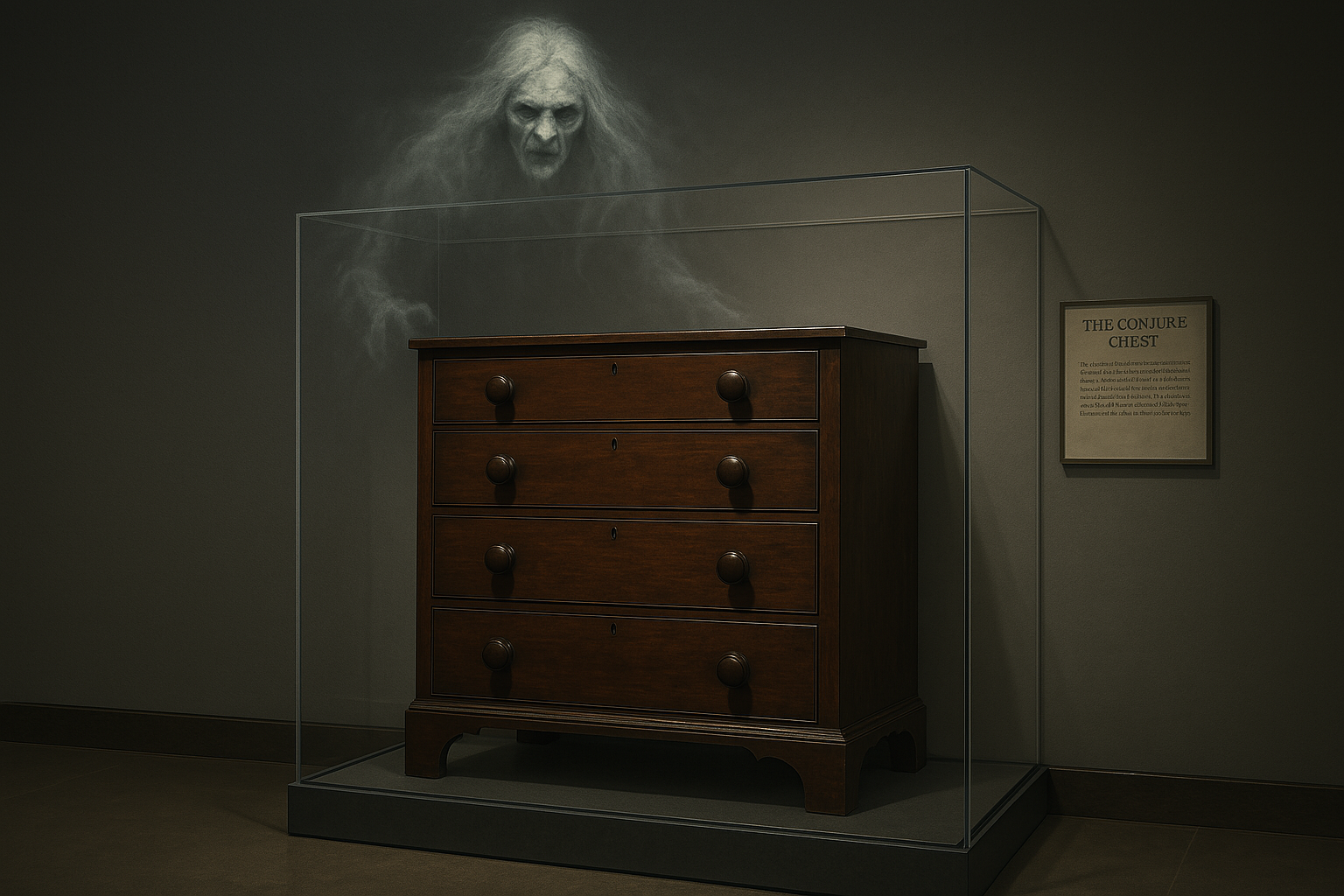
The Hope Diamond: Jewel of Calamity
Not all cursed objects are rusty old antiques; one of the most notorious resides in the prestigious Smithsonian Institution, dazzling under lights. The Hope Diamond, a large 45-carat blue diamond, is famed for its beauty – and its supposed curse. Originating from India, legend claims it was once the eye of a statue of a goddess, and anyone who stole or owned it unjustly would suffer misfortune. What’s chilling is how the history of the diamond, once it entered Western hands, indeed reads like a litany of woe. The French gem merchant who brought it from India, Jean Tavernier, was allegedly torn apart by wild dogs (a story likely apocryphal but widely repeated). King Louis XVI and Marie Antoinette had it as part of the French Crown Jewels – and we know their gruesome fate in the Revolution. Later owners in the 19th century encountered bankruptcy, scandal, even madness. A wealthy American heiress, Evalyn Walsh McLean, bought it in 1911, thinking herself immune to the curse. She loved the stone, wearing it at lavish parties – but thereafter her son died in a car accident, her daughter overdosed, and her husband was institutionalized before she lost everything. Eventually the diamond was sold to cover debts and ended up donated to the Smithsonian in 1958. Since then, the “curse” seems to have gone dormant – possibly because in a museum, it’s not truly owned by anyone, and thus the chain of personal misfortune is broken. The Hope Diamond’s legend looms large in any discussion of cursed items. While no ghost is said to be trapped in it, it embodies the concept of an object as a carrier of misfortune, perhaps guided by an unseen force or moral retribution. It also raises an interesting point: public institutions can be final refuges for these items. Once something is in a national museum under glass, it’s effectively off the market – a kind of protected custody, much like a magical quarantine. But it also means no Shadow Collector can have it (unless they were behind the donation to get it out of circulation). On occasion, fringe theorists suggest that some high-profile cursed objects in museums were actually placed there through the influence of secretive groups who wanted them where they could do no harm. The Hope Diamond, safely ensconced and hurting no one now, could very well be one of those cases where letting the public gawk at it ironically neutralized its dark tally of victims.
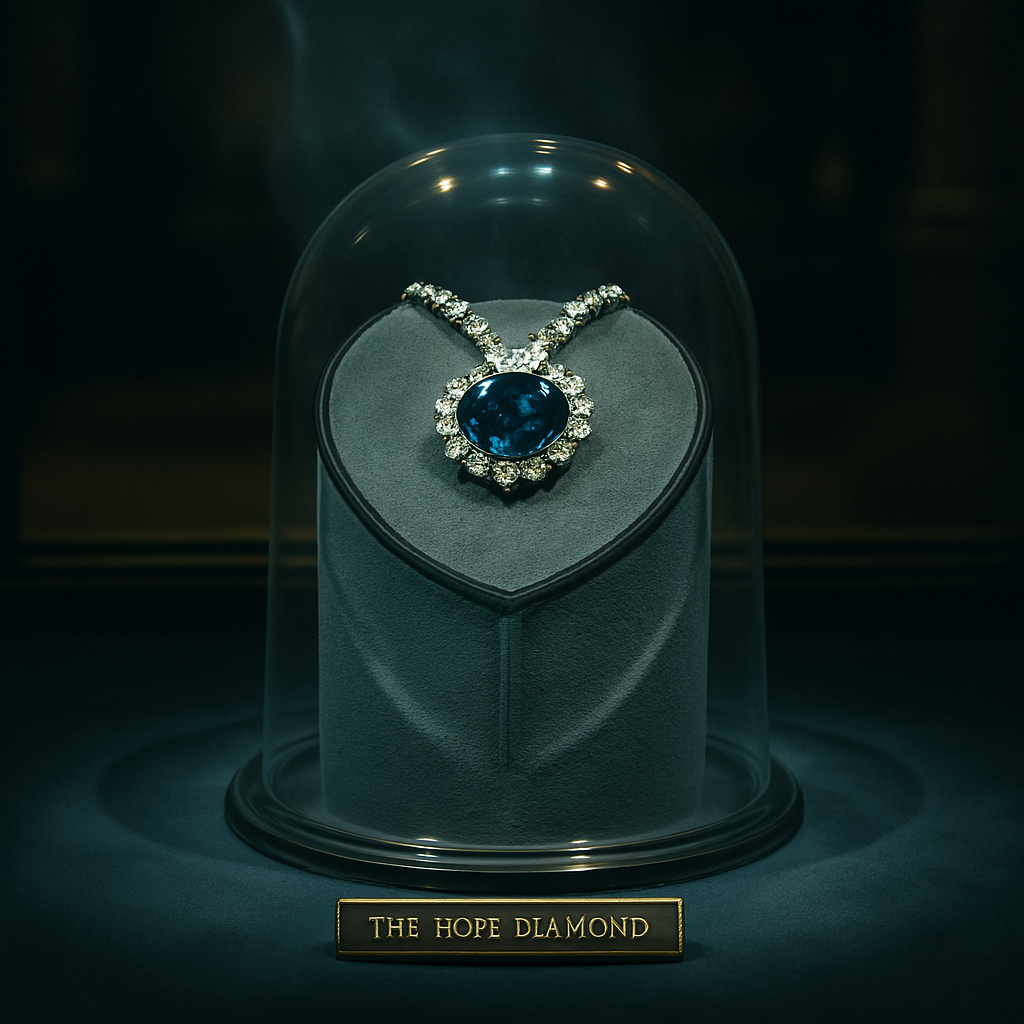
Robert and the Legion of Haunted Dolls
We would be remiss not to mention the broader phenomenon of haunted dolls, of which Annabelle is the superstar but by no means the only player. Robert the Doll, a century-old figurine in a little sailor suit, sits in a museum in Key West, Florida. He was once the beloved childhood toy of artist Robert Eugene Otto in the early 1900s. Eugene named the doll after himself and was inseparable from it. Servants whispered that the doll was voodoo-cursed by an unhappy maid, or perhaps Eugene’s intense energy simply “animated” it. Neighbors swore they saw the doll moving window to window when the family was out. Eugene, even as an adult, insisted Robert the Doll was alive and even blamed mishaps on the doll. After Eugene’s death, new owners of the house reported the doll’s expression changing, giggling sounds, and that it would appear in places on its own. Today, Robert resides in a glass case in a fort museum. Visitors who disrespect him (taking photos without permission, or joking about him) often send apology letters after experiencing car crashes, broken bones, and other bad luck post-visit. The museum has boxes of these repentance letters. Robert exemplifies an artifact with a caretaker (the museum curator) rather than an exploiter. They treat Robert with respect, almost as an employee or resident. Many Shadow Collectors, too, follow a similar path: they learn to live with the haunted items, respecting the entity attached rather than trying to dominate it. There are countless other dolls – Peggy (known to induce nausea and headaches at mere sight; now with Zak Bagans), Mandy (a creepy baby doll in Canada that allegedly moves and causes cameras to malfunction), the “Crying Boy” paintings (mass-produced prints in the 1980s UK, believed to cause fires unless kept with a matching portrait; many were voluntarily given up to fire stations to stop the curse). Each of these has either found a controlled home or had to be disposed of en masse to break the pattern. When a pattern emerges – multiple instances of the same cursed object as with the Crying Boy art – it often falls to a public effort (media, community) to neutralize it, since no single collector could hoard all copies. But with unique one-off items like Robert or Peggy, it just takes one brave (or curious) curator to take ownership and thereby assume the role of warden for that artifact.
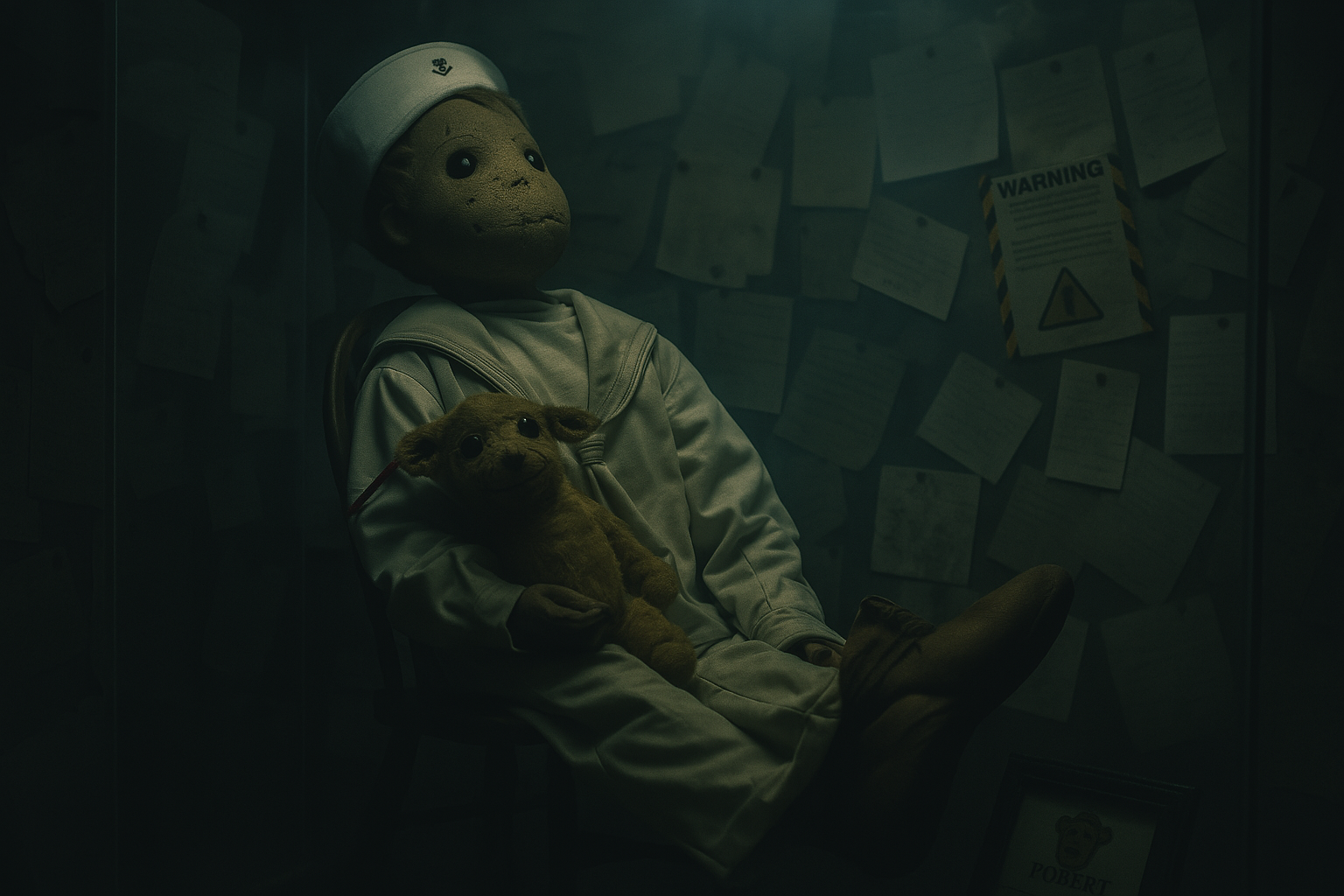
Private Chambers and “The Black Room”
Finally, beyond the named artifacts on public display, we return to those rumored private collections – the ones we can’t visit, but which surface fleetingly in anecdotes. There’s the story of “The Black Room” owned by an anonymous millionaire in Hong Kong: a climate-controlled vault where he stores a dozen or so of the most dangerous items he’s acquired through secret auctions. Among them, supposedly, is a Chinese oracle bone that screams when the full moon shines, and a mummified hand from a Malay ghost that grants deadly wishes. No one knows this man’s identity; the story was relayed by a retired art dealer who claimed to have brokered a sale of a haunted snuff box to him. Is it true, or a tall tale told over cocktails? Then there’s a tale out of Eastern Europe about a clandestine group calling themselves The Brotherhood of St. Lazarus, said to be affiliated with an old monastery. They quietly remove possessed religious statues or paintings that attract miraculous or demonic activity. People who encounter a weeping Madonna icon or a crucifix that moves on its own might find, overnight, that the object is gone – “spirited away” by the Brotherhood, to be locked in their vaults in the Carpathian Mountains. Again, hard evidence is absent, but local priests sometimes hint that it’s better certain relics aren’t seen by the public, hinting at this shadowy intervention. And consider Japan: Urban legend there speaks of a “Cursed Object Vault” in the basement of a major Tokyo shrine, where items like the mirror from the Okiku ghost mansion and a set of kanzashi hairpins said to be haunted by a wronged geisha are kept under lock and key by Shinto priests. The priests publicly deny any such vault exists, yet once a year, on a certain date, some shrines hold a ritual to pacify all spirits – one wonders if those hidden items are the reason, receiving their annual appeasement.
Each of these cases and tales, whether proven or whispered, contributes a thread to the tapestry of the Shadow Collectors’ world. Some artifacts end up in museums (their threat neutralized or at least under watchful eyes), others in the hands of well-known collectors who share their existence in books or shows, and many more remain behind closed doors – perhaps forever. For every haunted mirror hung in a tourist attraction, another might be tucked away in a billionaire’s mansion or a dusty church attic. The truth is likely a mix: there is no single “Museum of All Evil”, but rather a scattered array of mini-collections across the globe. Some owners share a noble intent to safeguard the world; others hold their prizes secret, savoring the power or mystery. In all cases, these artifacts have a way of binding not just spirits, but people – once you become the keeper of a ghostly object, your fate intertwines with it. Shadow Collectors know this better than anyone, and still, they continue their curious curation.
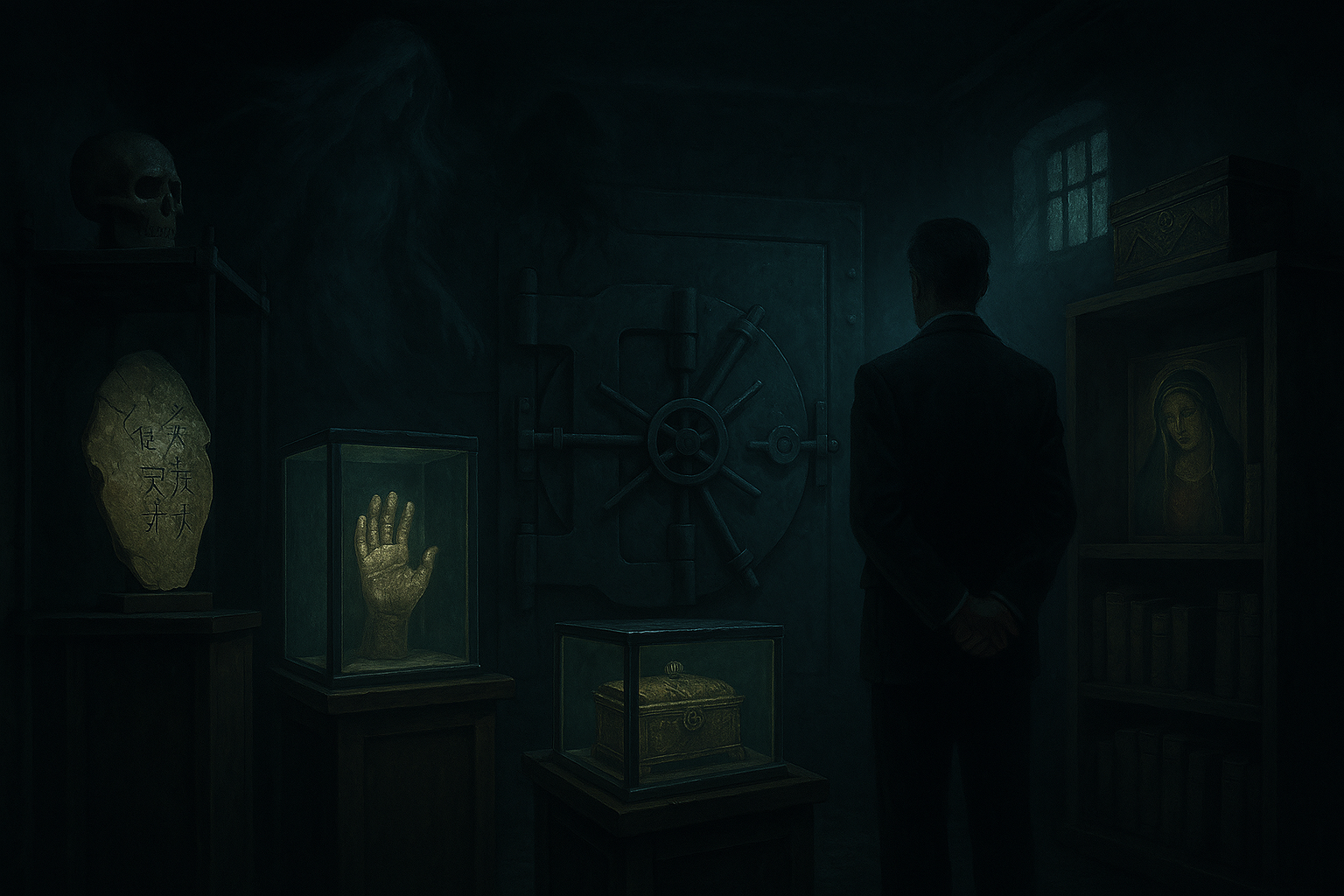
Epilogue: The Unresolved Mystery
The dossier closes here – at least, as much of it as can be known. What we’ve uncovered is a world that thrives on the border of the seen and unseen, where folklore steps into living rooms, and curiosities can bite back. The Shadow Collectors themselves remain, fittingly, in the shadows throughout. We catch glimpses: an old journal entry describing a secret auction, a newspaper clipping about a haunted doll donation, an anonymous tip about a locked vault in a church. But just when you think you’ve mapped the extent of their dealings, another rumor surfaces, another artifact changes hands under odd circumstances, renewing the chase.
In peeling back the layers, we found that the urge to trap ghosts and deal in haunted artifacts is a human response almost as old as ghost stories themselves. It springs from a simple yet profound impulse: to exert control over the uncontrollable. If something frightens us, perhaps we can capture it, own it, and thus nullify the fear – or, conversely, wield that fear to our advantage. The Shadow Collectors walk this knife’s edge between fear and fascination. They are part keepers of lore, part custodians of danger. Some might even be seen as unsung heroes, quietly preventing supernatural havoc by sequestering volatile objects. Others could just as easily be antagonists in the grand story – hoarders of forbidden power, playing with forces they only half understand.
What becomes of these collectors in the end? Do they retire, their secret cupboards full and their nerves frayed, wondering if the next whisper in the dark might be meant for them? Do they pass their troves to a successor, like a twisted inheritance? One imagines an old collector on his deathbed, keys trembling in hand as he bequeaths a hidden room of nightmares to a wide-eyed protege: “It’s your responsibility now.” Such a burden would not be enviable. For the artifacts seldom rest easy; a ghost in a box still yearns for freedom, a curse may hunger for a new victim. Perhaps the collectors themselves are as much prisoners as jailers, bound by the duty to keep the locks tight.
The modern world, with all its science and skepticism, hasn’t banished these shadows. If anything, technology and globalization have given new tools and pathways for the legends to travel. A TikTok video of a “cursed doll unboxing” can rack up millions of views, blurring entertainment and authenticity. An online forum might anonymously crowdsource an exorcism ritual for someone’s haunted heirloom. The shadows adapt. And surely, among those millions of viewers or forum lurkers, are the true Shadow Collectors, silently observing, looking for the next item that speaks to them – that calls to them in that peculiar way only those initiated in this world can sense.
As we conclude this investigation, questions inevitably outnumber answers. Are these phenomena real, or elaborate products of belief? If a secret society is containing dangerous relics, have they truly kept us safe, or simply kept tantalizing knowledge from the public? Does each object ultimately want to be found – ensuring its legend perpetuates by ensnaring new owners – making the Shadow Collectors unwitting pawns in the ghosts’ own games? The paradox of trying to own a haunt is that it just might end up owning you.
In the dim light of our collective curiosity, the figure of a Shadow Collector stands at a threshold – lantern in one hand, the other hand resting on a heavy chest bound with chains. Inside the chest, something scratches, faint but insistent. The collector hesitates. To keep it closed is to live with that perpetual scratching; to open it is to risk everything. What drives a person to choose the former, and what truly happens if they falter and choose the latter? That dilemma remains the heart of this mystery.
And so, we close with an unresolved cadence, fitting for a topic that by its nature resists finality. The last page of this lost dossier is smeared and torn, the ending sentence missing. Perhaps it was intentional – an unresolved ending to ensure the reader’s mind stays hooked in the mystery, much as a spirit might linger due to unfinished business. Or perhaps the Shadow Collectors themselves intercepted that final bit of truth, deeming the world not ready to know more.
In the end, we are left with a choice much like the collectors face: do we lock away these stories as mere eerie entertainment, or do we dare crack the lid a bit further, peering into the dark corners where history, belief, and the supernatural converge? The Shadow Collectors will continue their work regardless, unseen and unsung. Their collections will gather dust and whispers. And somewhere, sometime tonight, a phone will ring in a dusty study lined with odd artifacts – a tip off about a “situation” in a far-flung village. A chair that rocks by itself, a mirror that shows a second reflection. The collector will don their coat, take up their kit of relics and wards, and venture out once more into the mystery.
The shadows deepen, but the story goes on. The final truth of the Shadow Collectors remains elusive – a riddle bound in silence, awaiting the one who dares to unlock it.
